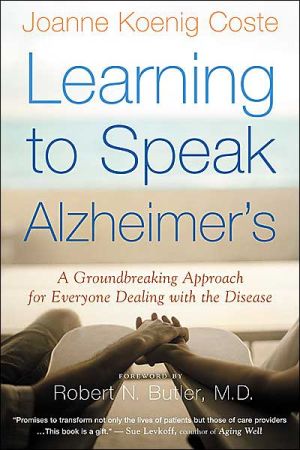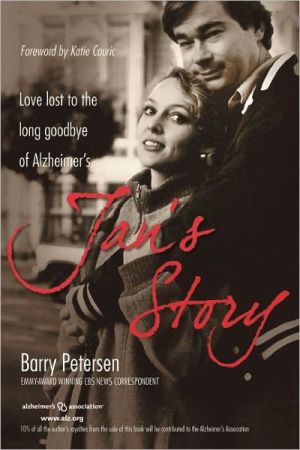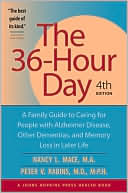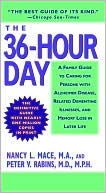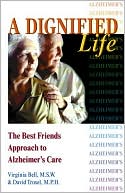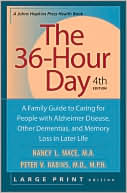Learning to Speak Alzheimer's: A Groundbreaking Approach for Everyone Dealing with the Disease
More than four million Americans suffer from Alzheimer’s, and as many as twenty million have close relatives or friends with the disease. Revolutionizing the way we perceive and live with Alzheimer’s, Joanne Koenig Coste offers a practical approach to the emotional well-being of both patients and caregivers that emphasizes relating to patients in their own reality. Her accessible and comprehensive method, which she calls habilitation, works to enhance communication between carepartners and...
Search in google:
This guide for families presents an approach to caring for people with Alzheimer's disease that emphasizes the importance of communicating with patients by focusing on their emotional language. Topics include, for example, understanding the diagnosis, respectfully stopping the patient from driving, establishing a plan of care, and enriching the patient's life. Supplemental information found in the appendix includes listings of support organizations and home health care products. Coste is a board member of the American Journal of Alzheimer's Disease Annotation © 2004 Book News, Inc., Portland, OR Library Journal After a major stroke left her husband paralyzed, unable to speak, and with significant progressive memory loss, Coste became his caregiver while raising four children. Refusing to institutionalize him, she developed a humanistic approach to caregiving ("habilitation") that focuses on enhancing the individual's remaining functional, intellectual, emotional, and spiritual abilities by creating a positive atmosphere that promotes feelings of success. Key elements of Coste's approach include simplifying the environment for the patient, capitalizing on his or her remaining skills, and making an effort to understand what life must be like for the memory impaired. Because such Alzheimer's behaviors as agitation and physical aggression are often rooted in frustration, she also offers caregivers techniques to help patients compensate for cognitive and sensory losses. Such methods include devising a daily routine filled with activities, physical exercise, snacks, and chores to reduce difficult behaviors and promote a good night's sleep. Directions for simple activities, recipes for nutritious "finger foods," and tips for hiring home caregivers are included. The level of care and involvement Coste describes is intense and may not be practical for all caregivers, but most activities can be modified to fit individual situations. A fine addition to Alzheimer's and caregiving collections. [Previewed in Prepub Alert, LJ 7/03.] Copyright 2003 Reed Business Information.
1\ The Ticking Meter\ My head feels like an old depot, worn by time and tears.\ No more locomotives passing through, café filled with tales and baggage.\ The old depot’s barren now.\ There has been a great brain robbery.\ One cool spring day in 1971, the kind that makes New Englanders smile at each other, I was driving with my husband down the main street of a small coastal town south of Boston. I spotted a parking space in front of our destination, a café where we dined frequently, sharing chowder, fried clams, gigantic iced teas, and dreams of the future.\ I told my husband, Look, there’s a parking space. Not only that—there’s money in the meter.” I’m glad,” he murmured, seeking my eyes through his sunglasses. But I think my meter is running out.” His metaphor fell on deaf ears. With a new life growing inside me—our fourth child—I may have been unwilling to accept his meaning.\ At the time my husband’s lapses in memory seemed innocuous. He might forget a neighbor’s name or neglect to stop at the store or forget where the ignition was in the car, but I was clever at disregarding the hints of medical illness. After all, he frequently drove different cars as part of his advertising business, and he was so busy; keeping up with minor details was too much to expect. The situation will improve when we move into a new house, I told myself, or when the children are older, or when someone in the medical community will listen to what I am saying.\ We moved, the children grew, and the improvement never happened. We were near financial ruin. Customers weren’t calling us back; new jobs weren’t coming our way. He had ever greater difficulty focusing and organizing his thoughts, sometimes rewriting ad copy he had finished the day before. Once so gentle, docile, and fun to be around, he became frustrated and angry. My mantra continued whenever I was awake: Things will be so much better when—” When?\ Our journey into the world of dementia began in 1971, when no guideposts, advocates, manuals, or support groups were available to help us. The National Alzheimer’s Association would not be organized for another decade. My husband was only in his forties, and I did not believe that his forgetfulness was a natural part of aging. The children chided their father occasionally about his absent-mindedness” but seemed to see nothing deeper. The prescription for Valium to treat his supposed depression” was refilled many times. And sometimes my husband unwittingly doubled the dose or forgot to take it at all.\ Always well dressed in the past, my handsome, athletic husband began to need help matching his suit, tie, and shirt. I started to lay out his clothes for the next day before we went to bed at night. I made sure to tell him what fun I had selecting the outfits, but I was embarrassed to be doing this task. I never mentioned it to others.\ Then in 1973, a major stroke paralyzed him on one side, and I replaced the Brooks Brothers suits with sweatsuits, which he soon stained with food. The stroke took away his language ability, transforming a man who had made his living through eloquent writing into someone who had to rely entirely on words of one syllable. Neurologists and physical therapists told me not to expect any improvements in his speech though he did learn to walk again, ever so slowly, with a leg brace and a walker. Life was very hard for all of us, but it was especially horrible for my husband. He became frustrated beyond comprehension.\ At times he did not seem to recognize our children or me. Sometimes he appeared thoroughly perplexed about our home. I remember him angrily rattling the doorknob in an effort to go outside but not being able to open the door. And yet I also recall his having enough of his former self that when he looked at our young baby, tears would run down his face.\ His abilities continued to decline. As soon as I became the least bit comfortable with his current condition, he would take another step in the downhill progression of dementia. I felt completely overwhelmed. At times I was diapering both our youngest child and my husband. There’s no way I can do this, I would think to myself.\ Finally things came to a head. My husband kept opening the door to go outside—as if to escape from what was happening to him—and my toddler would follow him out. Soon our son started trying to open the door and walk out on his own (this was before safety devices were so readily available). I realized I had to act—proactively, positively, and immediately, before my husband and son left home and got lost. I installed a new handle higher on the door, leaving the old knob intact but disabled. My son could no longer rreach the door. More incredibly to me, my husband didn’t understand the concept of the new handle: he would repeatedly go over to the door, try the olddddd knob, and think that the door was broken.\ This tiny event made me realize that I could make some changes in the way we were living. I could stop walking on eggshells, in fear of what would happen next, and start making a positive difference in our surroundings and in my approach to his illness. I’m a very competitive person, and I started thinking of the entire situation as a game—a brand-new game I wanted to win. I knew I had to get suited up and be ready to play. Each daily task—eating, dressing, toileting, everything—was a new inning, a new round in this game.\ I stopped making excuses for the changes in his behavior and the decline in his cognitive functions. The neurologist had told me that my husband’s disease was progressive and would be fatal—and in an odd way, that knowledge helped me. It gave me the energy I needed to cope with what he and I both faced, because I knew that the situation would not go on forever.\ I vowed to learn to live with this person who was inhabiting the body of the man I cherished. I had to detach myself emotionally from the man my husband used to be and live now with the man he had become. The task at hand—this minute, and every minute of every day—was to ensure my family’s survival; I couldn’t waste time focusing on my lot in life. I had to deal with the reality of today.\ I decided not to heed the hospital social workers who told me that my husband would be fine” if he went to live at an institution for the mentally ill or at a nursing home for the elderly, where he would be with others suffering from dementia. In that era, I did not trust that hospital and nursing- home workers would try to connect with him. And I knew that if he stayed at home, I could still reach parts of this man. A great deal of the time, his emotions seemed akin to mine. If I can reach him on an emotional level, I thought, instead of on a verbal or cognitive one, maybe life can be less threatening and frustrating for him.\ I started a two-part list of issues related to his illness. Those elements that I thought could be changed, ameliorated, or implemented I put in part one. The elements that no amount of concentrated effort could ever change I listed in part two. I wrote improved mobility” on the first list, while I relegated return of speech” to the second. I placed daily laughter” on the list of goals that could be implemented and planting the garden” on the list of those that could not. Eventually my lists filled a spiral-bound notebook, with several hundred entries.\ After putting into practice the ideas and goals on the first list, I found that a smile from my husband, calmness in our household, meant a win for all of us. I wanted to laugh at the end of the day, not curl up in a corner or break down in despair.\ From the items in my notebook I developed five simple tenets, which I now teach to people who care for patients with Alzheimer’s disease or related forms of progressive dementia such as vascular dementia, Pick’s disease, and Lewybody disease. These ideas are the basis for the humanistic approach to caring that I call habilitation.” The literal meaning of habilitate is to clothe or dress,” but I use it in the sense of to make capable,” which is actually an older meaning of the word. A habilitated person with dementia can live using his or her upper limits of function, intellect, emotion, and spirit. Using the tenets of habilitation, both patients and care partners can feel successful at what they do, rather than feeling constantly weighted down. (I prefer the terms care partner” or habilitator” to caregiver,” which assumes less involvement on the part of the patient.) The following are the tenets that I developed, first for my own use at home and later for the use of other patients with dementias.\ 1. Make the Physical Environment Work. Simplify the environment. Accommodate perceptual loss by eliminating distractions.\ 2. Know That Communication Remains Possible. Remember that the emotion behind failing words is far more important than the words themselves and needs to be validated. Although many losses occur with this disease, assume that the patient can still register feelings that matter.\ 3. Focus Only on Remaining Skills. Value what abilities remain. Help the patient compensate for any lost abilities without bringing them to his or her attention.\ 4. Live in the Patient’s World. Never question, chastise, or try to reason with the patient. Join her in her current place” or time, wherever that may be, and find joy with her there.\ 5. Enrich the Patient’s Life. Create moments for success; eliminate possible moments of failure, and praise frequently and with sincerity. Attempt to find humor wherever possible.\ These tenets require continuous examination of how the patient thinks, feels, communicates, compensates, and responds to change, emotion, and love. Improving understanding in these areas can lead to the biggest successes in treatment.\ Along with my direct experience, my decades of work with professional and family care partners have shown that the habilitation approach works. Having worked with thousands of patients and care partners over the years, I have come to know that even people with fatal neurological illnesses still possess the innate drive to maximize their potential. After observing the success of the habilitation approach, colleagues and friends began to study and implement the tenets themselves, easing the burden of care partners, developing activities for Alzheimer’s patients, studying those in long-term care, and addressing their special architectural and interior design needs. All of these researchers from varying disciplines have long believed in and studied the innate drive that remains in people with neurological diseases such as Alzheimer’s. This shared belief has led to a clearer understanding of why we should continue to focus on patients’ positive aspects and remaining skills.\ During the years I care partnered with my husband, I clarified the tenets, and both he and I were able to succeed at living under our changed circumstances. When he died in 1976, I moved back to my parents’ home with our four children, whose ages ranged from four to sixteen. I had told my parents that I wanted to stay with them just for a few weeks to figure out what I should do with the rest of my life; instead I stayed for fifteen years. The children grew up, and I bandaged cut fingers and injured spirits. They participated in Pop Warner football, Little League baseball, high school soccer, track, and championship swimming. They found friendship and love and went on to colleges and careers. Now that they are enriching the lives of others, I often wonder how they would have matured without the years of turmoil and distress, fear of the unknown, and terror of the known that they endured. Perhaps support and love for all of our family—my husband included—offset family tragedy.\ After moving in with my parents, I immediately began working as a nursing assistant in a nursing home run by a local hospital. I soon became director of restorative services, which let me initiate a program to try to help several residents who had progressive dementias—and who at that time bore such lofty diagnoses as organic” and chronic” brain syndrome. Before long, newly admitted people wanted to be included in the program, which was based on the habilitative tenets described above. I led daily sessions with the patients, worked with the care partners at the facility, and developed a support group for spouses. I have been leading such groups continually since 1978, and this work remains a great joy in my life.\ The nursing home developed a special-care unit for the patients in the program, and soon we recognized that they were doing much better cognitively than they had done before and were participating more fully in daily living activities, such as dressing and bathing. All of the patients appeared calmer, which meant that their medications could be reduced. In this unit, restraints were removed; hugs were instituted.\ After successfully mentoring the staff and performing daily cognitive and supportive interactions with a population that grew to comprise more than half of the patient roster at the facility, I attempted to have this new kind of care—the habilitative approach—recognized by state and national regulatory agencies concerned with confidentiality and the right to a private diagnosis. But in the 1970s, civil libertarians and others were loath to have specific beds set aside for patients with dementias. They were concerned that such groupings would reveal the patients’ diagnoses, which would be an invasion of privacy.\ I was very lonely during that time. I had no one to talk to about changing the scene for cognitively impaired adults. Alzheimer’s was beginning to be given as a diagnosis, even though it was treated as a brand- new discovery; but except for a few colleagues at the nursing home, no one was willing to listen to my ideas. I was so elated when I discovered John Panella at Cornell University, who was studying the impact of special programming on patients with Alzheimer’s disease at a day care facility in White Plains, New York. At last I had discovered someone else who believed that we could make a difference in the lives of Alzheimer’s patients.\ The establishment in 1980 of the National Alzheimer’s Association gave me and the growing number of concerned individuals and organizations renewed courage to fight for specialized housing and programming. By 1981 the program at the nursing home where I worked became an officially sanctioned special unit. As attempts to duplicate it popped up all over the Northeast, I became happily busy teaching and mentoring.\ During the next two decades, the National Alzheimer’s Association grew, with branches in every state offering family support and patient care, professional education, research opportunities, and advocacy. And as other professionals became interested in the care of people with Alzheimer’s, the effort to institute habilitative settings became easier. Advocates traveled to state houses and government agencies to describe the major differences that specialized care made in the lives of Alzheimer’s patients, their families, and the staff of institutions caring for them. Special- care units now exist in every region of the United States, and specific programming for people with Alzheimer’s disease and the related disorders are common in adult day health, assisted-living, and retirement centers.\ Still, families need to be wary of institutions that claim to offer specialized care but do little more than secure the doors. Without trained staff, ongoing education, and a habilitative philosophy of care adopted by the whole staff, the unit is not special.” Both the National Alzheimer’s Association and its state chapters can help sort through the differences.\ For people seeking care for patients outside the home, as well as those planning to provide care themselves, this book teaches both the habilitation philosophy and the practical techniques that make care partnering effective and enriching. It focuses primarily on the early and middle stages of Alzheimer’s and other progressive dementias, when habilitative care can be most effective.\ This book is divided into three parts. In Part One, to foster an understanding of Alzheimer’s disease and to underscore how altered behavior relates to the changes in the brain, I present an overview of the disease in lay terms. I then discuss some of the most common issues immediately affecting people with Alzheimer’s.\ Part Two moves into the core idea of habilitation—creating a positive milieu in which the patient can enjoy feelings of success. I focus on basic, simple suggestions for use of leisure time and offer practical solutions for bathing, dressing, toileting, and eating independently. I include tips for communication and for dealing with negative behaviors.\ Part Three discusses the need for care partners to take care of themselves and provides a summary of short- and long-term-care options most conducive to the habilitation principles.\ At the end of the book, the Appendix and Further Resources provide the most practical, useful information I’ve been able to compile—from simple finger food suggestions to books and other reference materials to companies and dealers who specialize in materials I use in my habilitation work.\ Most of the anecdotes used throughout the book are composites based on stories I have heard through the years or incidents in which I was a participant. While the dialogue is often based only on my impressionistic memory, the deeper truth contained in each vignette is real. I selected the anecdotes to show what remains in the heart and soul of the person with Alzheimer’s disease or other progressive dementia, and to help care partners move into the patient’s world and focus not on what is missing but on what is still there.\ If you are a care partner, remember to be kind to yourself as you read through the ideas presented here. Do not try to implement all the ideas at once, since that would be overwhelming. After all, the goal of habilitation is to create a positive emotional and physical environment for the care partner as well as for the patient. Figuring out what most needs to be done at any moment makes achieving the overall goal far more manageable. Congratulate yourself on what you can do.\ Copyright © 2003 by Joanne Koenig Coste. Reprinted by permission of Houghton Mifflin Company.
ForewordxiPart 1Learning about Alzheimer's1.The Ticking Meter32.Seeking a Correct Diagnosis133.What to Expect: Making the First Decisions204.Habilitation, the New Approach325.Seeing the World from the Patient's Perspective48Part 2The Five Tenets of Habilitation6.Tenet #1: Make the Physical Environment Work617.Tenet #2: Know That Communication Remains Possible778.Tenet #3: Focus on Remaining Skills859.Tenet #4: Live in the Patient's World: Behavioral Changes10810.Tenet #5: Enrich the Patient's Life127Part 3Beyond Habilitation11.Caring for the Care Partner14912.Receiving Home Care16313.Receiving Care Outside of a Family Home17614.Inspiration193Glossary203AppendixGood Food for People with Alzheimer's206Further Resources212Index229
\ Library JournalAfter a major stroke left her husband paralyzed, unable to speak, and with significant progressive memory loss, Coste became his caregiver while raising four children. Refusing to institutionalize him, she developed a humanistic approach to caregiving ("habilitation") that focuses on enhancing the individual's remaining functional, intellectual, emotional, and spiritual abilities by creating a positive atmosphere that promotes feelings of success. Key elements of Coste's approach include simplifying the environment for the patient, capitalizing on his or her remaining skills, and making an effort to understand what life must be like for the memory impaired. Because such Alzheimer's behaviors as agitation and physical aggression are often rooted in frustration, she also offers caregivers techniques to help patients compensate for cognitive and sensory losses. Such methods include devising a daily routine filled with activities, physical exercise, snacks, and chores to reduce difficult behaviors and promote a good night's sleep. Directions for simple activities, recipes for nutritious "finger foods," and tips for hiring home caregivers are included. The level of care and involvement Coste describes is intense and may not be practical for all caregivers, but most activities can be modified to fit individual situations. A fine addition to Alzheimer's and caregiving collections. [Previewed in Prepub Alert, LJ 7/03.] Copyright 2003 Reed Business Information.\ \
